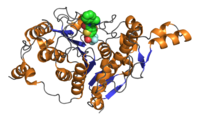
Photo from wikipedia
A systematic look at a childhood tumor Neuroblastomas—the most common tumor type in infants—develop from fetal nerve cells, and their clinical course is highly variable. Some neuroblastomas are fatal despite… Click to show full abstract
A systematic look at a childhood tumor Neuroblastomas—the most common tumor type in infants—develop from fetal nerve cells, and their clinical course is highly variable. Some neuroblastomas are fatal despite treatment, whereas others respond well to treatment and some undergo spontaneous regression without treatment. Ackermann et al. sequenced more than 400 pretreatment neuroblastomas and identified molecular features that characterize the three distinct clinical outcomes. Low-risk tumors lack telomere maintenance mechanisms, intermediate-risk tumors harbor telomere maintenance mechanisms, and high-risk tumors harbor telomere maintenance mechanisms in combination with RAS and/or p53 pathway mutations. Science, this issue p. 1165 Neuroblastomas that are positive for telomere maintenance mechanisms are associated with a poorer prognosis. Neuroblastoma is a pediatric tumor of the sympathetic nervous system. Its clinical course ranges from spontaneous tumor regression to fatal progression. To investigate the molecular features of the divergent tumor subtypes, we performed genome sequencing on 416 pretreatment neuroblastomas and assessed telomere maintenance mechanisms in 208 of these tumors. We found that patients whose tumors lacked telomere maintenance mechanisms had an excellent prognosis, whereas the prognosis of patients whose tumors harbored telomere maintenance mechanisms was substantially worse. Survival rates were lowest for neuroblastoma patients whose tumors harbored telomere maintenance mechanisms in combination with RAS and/or p53 pathway mutations. Spontaneous tumor regression occurred both in the presence and absence of these mutations in patients with telomere maintenance–negative tumors. On the basis of these data, we propose a mechanistic classification of neuroblastoma that may benefit the clinical management of patients.
Journal Title: Science
Year Published: 2018
Link to full text (if available)
Share on Social Media: Sign Up to like & get
recommendations!